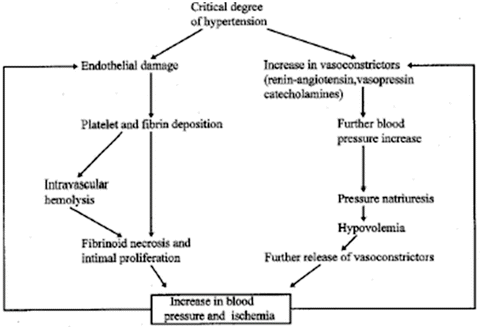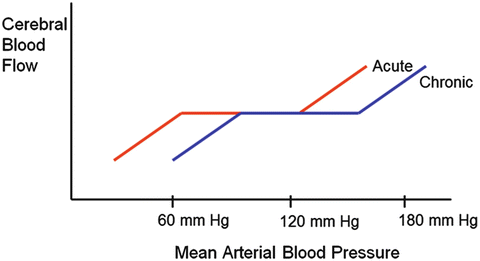(1)
Division of Pulmonary and Critical Care Medicine, Eastern Virginia Medical School, Norfolk, VA, USA
Keywords
HypertensionHypertensive urgencyHypertensive emergencyNicardipineClevidipineLabetalolAortic dissectionEclampsiaPosterior reversible encephalopathy syndrome (PRES)Hypertensive encephalopathyAcute myocardial infarction (AMI)Cardiogenic pulmonary edemaMicroangiopathic hemolytic anemiaPostoperative hypertensionHypertensive emergencies and hypertensive urgencies (see definitions below) are commonly encountered by a wide variety of clinicians. It is estimated that 1–2 % of patients with hypertension will develop a hypertensive crises at some point in their lifespan. The epidemiology of hypertensive emergencies parallels the distribution of essential hypertension with a higher incidence among the elderly and African-Americans [1, 2]. Prompt recognition, evaluation and appropriate treatment of these conditions are crucial to prevent permanent end organ damage.
Definitions
The classification and approach to hypertension undergoes periodic review by the Joint National Committee (JNC) on Prevention, Detection, Evaluation, and Treatment of High Blood Pressure with the most recent report (JNC 8) having been released in 2014 [3]. This most recent report is quite controversial and unlike previous reports did not provide a classification of hypertension. The previous report published in 2003 (JNC 7) recognized two stages of hypertension (compared to the previous four stages in JNC 6), namely, Stage 1 with a Systolic BP (SBP) of 140–159 and a diastolic BP (DBP) of 90–99 and Stage II hypertension with a SBP ≥ 160 or a DBP ≥ 100 mmHg [4]. Although not specifically addressed in the JNC 7 report, patients with a systolic blood pressure of greater than 179 mmHg or a diastolic that is greater than 109 mmHg are usually defined as having a “hypertensive crisis”. The 1993 report of the JNC proposed an operational classification of hypertensive crises as either “hypertensive emergencies” or “hypertensive urgencies” [5]. This classification remains useful today. Severe elevations in BP were classified as:
Hypertensive emergencies in the presence of acute end-organ damage or
Hypertensive urgencies in the absence of acute target-organ involvement.
Distinguishing hypertensive urgencies from emergencies is critically important in formulating a therapeutic plan. Patients with hypertensive urgency should have their BP reduced within 24–48 h (with PO medication), whereas patients with hypertensive emergencies should have their blood pressure lowered immediately (in the ICU), although not to “normal” levels. The term “malignant hypertension” has been used to describe a syndrome characterized by elevated BP accompanied by encephalopathy or acute nephropathy. This term, however, has been removed from National and International Blood Pressure Control guidelines and is best referred to as a hypertensive emergency.
Hypertensive urgencies are treated with oral antihypertensive agents usually on an outpatient basis
Hypertensive emergencies are treated in the ICU with a rapidly acting, titratable, intravenous antihypertensive agent
The vast majority of patients presenting with a hypertensive emergency to an emergency department (ED) have previously been diagnosed with HTN and have been prescribed antihypertensive agents [6, 7]. However, in many of these patients BP control prior to presentation was inadequate [7]. The lack of a primary care physician as well as the failure to adhere to prescribed antihypertensive regimens has been associated with the development of a hypertensive emergency [6, 8]. In the prospective study by Saguner and colleagues, female sex, high grades of obesity, coronary artery disease and non-adherence to medications were associated with hypertensive crisis [9]. In both major metropolitan areas and smaller communities, illicit drug use has been reported to be a major risk factor for the development of hypertensive emergencies [8].
The Studying the Treatment of Acute hypertension (STAT) is a 25-institution US registry of 1,588 patients with severe acute hypertension enrolled between January 2007 and April 2008 who were treated with intravenous therapy [10]. The mean age of the patients was 53 years, 49 % were women and 56 % were African American with a median admission BP of 200/100 mmHg. In the STAT registry the hospital mortality was 6.9 % with an aggregate 90-day mortality of 11 % and a 90-day readmission rate of 37 %.
Pathophysiology
The factors leading to the severe and rapid elevation of BP in patients with hypertensive emergencies are poorly understood. The rapidity of onset suggests a triggering factor superimposed on pre-existing hypertension. Hypertensive emergencies are thought to be initiated by an abrupt increase in systemic vascular resistance likely related to humoral vasoconstrictors [11]. The subsequent increase in BP generates mechanical stress and endothelial injury leading to increased permeability, activation of the coagulation cascade and platelets, and deposition of fibrin (See Fig. 28.1). With severe elevations of BP, endothelial injury and fibrinoid necrosis of the arterioles ensue. This process results in ischemia and the release of additional vaso-active mediators generating a vicious cycle of on-going injury. The volume depletion that results from pressure natriuresis further simulates the release of vasoconstrictor substances from the kidney. These collective mechanisms can culminate in end-organ hypoperfusion, ischemia and dysfunction that manifests as a hypertensive emergency.


Fig. 28.1
Proposed pathophysiology of hypertensive emergency
Clinical Presentation
The clinical manifestations of a hypertensive emergency are directly related to the particular end-organ dysfunction that has occurred, and includes:
Hypertensive encephalopathy (and PRES)
Acute aortic dissection
Acute myocardial infarction
Acute coronary syndrome
Pulmonary edema with respiratory failure
Severe pre-eclampsia, HELLP syndrome, eclampsia
Microangiopathic hemolytic anemia
Acute postoperative hypertension
The signs and symptoms of a hypertensive crisis vary from patient to patient. In the STAT registry the most common presenting symptoms included shortness of breath (29 %), chest pain (26 %), headache (23 %) altered mental status (20 %) and focal neurologic deficit (11 %) [10]. Microangiopathic hemolysis has been reported in up to 27 % of patients presenting with a hypertensive crisis [12]. It is important to make this diagnosis as it is usually associated with reversible renal insufficiency. No particular BP threshold has been associated with the development of a hypertensive emergency. However, organ dysfunction is uncommon with a DBP less than 130 mmHg (except in children and pregnancy) [13]. The absolute level of BP may not be as important as the rate of increase [14–16]. For example, in patients with long-standing hypertension, SBP of 200 mmHg or a DBP up to 150 mmHg may be well tolerated without the development of hypertensive encephalopathy, whereas in children and pregnant women encephalopathy may develop with a DBP of only 100 mmHg [17].
Initial Evaluation
Patients with hypertensive emergency usually present for evaluation as a result of a new symptom complex related to their elevated BP. Patient triage and physician evaluation should proceed expeditiously to prevent ongoing end organ damage.
A focused medical history should include:
History of hypertension, previous control, current anti-hypertensive medications with dosing, compliance, and time from last dose
The use of any prescribed or over-the-counter medications
Use of recreational drugs (amphetamines, cocaine, phencyclidine) or monoamine oxidase inhibitors should be made.
Physical examination should:
Confirm the elevated BP by measuring the BP in both arms with an adequately sized cuff.
The appropriate size cuff is particularly important as the use of a cuff too small for the arm size has been shown to artificially elevate BP readings in obese patients.
Identify evidence of end-organ damage by assessing
pulses in all extremities
auscultating the lungs for evidence of pulmonary edema, the heart for murmurs or gallops and the renal arteries for bruits and
perform a focused neurologic and funduscopic examination.
Headache and altered level of consciousness are the usual manifestations of hypertensive encephalopathy. Focal neurological findings, especially lateralizing signs, are uncommon in hypertensive encephalopathy being more suggestive of a cerebrovascular accident. Subarachnoid hemorrhage should be considered in patients with a sudden onset of a severe headache. The ocular exam may show evidence of advanced retinopathy with arteriolar changes, exudates, hemorrhages or papilledema assisting in the identification of hypertensive encephalopathy. Cardiac evaluation should aim to identify angina or myocardial infarction with the focus on clarifying any atypical symptoms such as dyspnea, cough, or fatigue that may be overlooked. Severe renal injury may result in hematuria or oliguria. On the basis of this evaluation, the clinician should be able to distinguish between a hypertensive emergency or an urgency and to formulate the subsequent plan for further diagnostic tests and treatment.
Initial objective evaluation should include:
A metabolic panel to assess electrolytes, creatinine and blood urea nitrogen
A complete blood count (and smear if microangiopathic hemolytic anemia is suspected)
A urinalysis to look for proteinuria or microscopic hematuria,
An electrocardiogram to assess for cardiac ischemia
Radiographic studies such as a chest radiograph in a patient with cardiopulmonary symptoms or a head computed tomography scan in a patient with neurologic symptoms should be obtained in the appropriate clinical scenario
If the physical examination or clinical picture is consistent with aortic dissection (severe chest pain, unequal pulses, widened mediastinum), a contrast computed tomography scan of the chest should be obtained promptly to rule out aortic dissection. Although trans-esophageal echocardiography has excellent sensitivity and specificity for aortic dissection, this study should not be performed until adequate blood control has been achieved.
In patients presenting with pulmonary edema it is important to obtain an echocardiogram to distinguish between diastolic dysfunction, transient systolic dysfunction or mitral regurgitation. Many patients, particularly the elderly, have a normal ejection fraction and in such patients heart failure is due to isolated diastolic dysfunction. The management these patients differs from those patients with predominant systolic dysfunction and those with transient mitral regurgitation.
Initial Management of Blood Pressure
The majority of patients in whom severe hypertension (SBP > 160, DBP > 110 mmHg) is identified on initial evaluation will have no evidence of acute end-organ damage and thus have a hypertensive urgency. Since no acute end-organ damage is present, these patients may present for evaluation of another complaint and the elevated BP may represent an acute recognition of chronic hypertension. In these patients, oral medications to lower the BP gradually over 24–48 h is the best approach to management [11]. Rapid reduction of BP may be associated with significant morbidity in hypertensive urgency due to a rightward shift in the pressure/flow auto-regulatory curve in critical arterial beds (cerebral, coronary, renal) (see Fig. 28.2). Rapid correction of severely elevated BP below the autoregulatory range of these vascular beds can result in marked reduction in perfusion causing ischemia and infarction. Therefore, although the BP must be reduced in these patients, it must be lowered in a slow and controlled fashion to prevent organ hypoperfusion.


Fig. 28.2
The autoregulatory range is shifted to the right in chronic hypertension. Overzealous BP reduction below the autoregulatory rang eof the brain, heart or kidney will predictably result in organ infarction
 Patients with hypertensive urgency should NOT receive intravenous antihypertensive agents. If you feel compelled to treat with an IV agent give yourself or the bed-side nurse some Ativan!
Patients with hypertensive urgency should NOT receive intravenous antihypertensive agents. If you feel compelled to treat with an IV agent give yourself or the bed-side nurse some Ativan!Resident (or Hospitalist) Called to the Floor for High Blood Pressure: What to Do?
Check BP yourself (in both arms with an adequately sized cuff)
Review chart
Hx of HTN, CAD, drug or alcohol use
Current anti-HTN meds
Examine patient
Hypertensive EMERGENCY—call ICU
Hypertensive urgency
Treatable causes of high BP
Pain, anxiety, distended bladder, hypothermia, hypoxic, volume depletion, drug or alcohol withdrawal
Calm and reassure nurse
PO anti-HTN medication: metoprolol, lisinopril, etc
Altered autoregulation also occurs in patients with hypertensive emergencies and since end-organ damage is already present, rapid and excessive correction of the BP can further reduce perfusion and propagate further injury. Therefore, patients with a hypertensive emergency are best managed with a continuous infusion of a short-acting, titratable antihypertensive agent. Due to unpredictable pharmacodynamics, the sublingual and intramuscular route should be avoided. Patients with a hypertensive emergency should be managed in an ICU with close monitoring. For those patients with the most severe clinical manifestations or with the most labile BP, intra-arterial BP monitoring may be prudent. There are a variety of rapid-acting intravenous agents that are available for use in patients with hypertensive emergency; the agent of choice depends on the organ system involved (see Table 28.1):
Table 28.1
Preferred antihypertensive agents for hypertensive emergency
Condition | Preferred agents |
|---|---|
Acute pulmonary edema-systolic dysfunction | Nicardipine or clevidipine in combination with nitroglycerin and a loop diuretic |
Acute pulmonary edema-diastolic dysfunction | Esmolol, metoprolol, labetalol or verapamil in combination with low dose nitroglycerin and loop diuretic |
Acute myocardial ischemia | Esmolol or labetalol in combination with nitroglycerin |
Hypertensive encephalopathy and PRESS | Nicardipine, clevidipine or labetalol |
Acute aortic dissection | Labetalol or combination of nicardipine and esmolol or nitroprusside with esmolol/metoprolol |
Eclampsia | Labetalol or nicardipine |
Acute renal failure/microangiopathic hemolytic anemia | Nicardipine or clevidipine |
Sympathetic crisis/cocaine

Full access? Get Clinical Tree
 Get Clinical Tree app for offline access
Get Clinical Tree app for offline access

|


